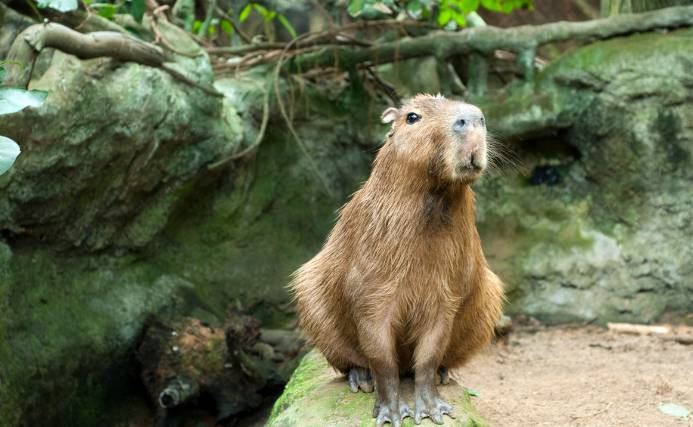Seeing cute and calm creature like capybaras have caused me to know about their home outside. Finally, I get to realize the zones.
So, where do capybaras live? It can be expressed in 3 stages which are:
- Season
- Winter: Craft beds using straw and mulch.
- Summer: Stay underwater and shade (like trees, misters, and so on).
- Rain: Take shelter under trees, or houses.
- Lifestyle
- Wildlife: Survive nearby lakes and the flooded savannah.
- Captivity: Stay in an enclosed house that has space and food.
- Geographic Location
- US, Panama, Africa, Colombia, Venezuela, Brazil, Paraguay, and so on.
Learn more about this topic below to get an in-depth idea!

Exactly Where Do Capybaras Live in Different Seasons!
As friendly creatures, the water hogs will pick a decent place to live and continue their new journey based on the season. Here’s the detail:
In Winter
It’s true that rodent creatures like capybaras can bear coldness to survive outside. And the limit of survival temperature is around 4 °C (40 °F) at the lowest peak.
When the temperature starts to drop toward the lowest, they move to a warm area where they feel secure and can sleep comfortably.
Like, they built beds out of straw, hay grass, and mulch in a separate house. They also choose a home around the topical forest that has a deep shelter-like home to stay there in peace.
In Summer
When the season changes to hot summer, capybara’s homes also alter and come close to water (their favorite place).
The survival temperature in the summer season is up to 32 °C – 38 °C (90 °F – 100 °F) where the humidity level stands in the 30% – 70% range. At that temperature, they move to the watery zone and shade (meaning below trees).
You’ll mostly see them enjoying mud wallows, misters, ponds, big plants, shade clothes, and indoor spaces. That way they keep themselves relaxed and hydrated without feeling extremely hot at the same time.
In Rain
Capybaras just hide under big branches, trees, or houses where the roof is sealed or covered to get rid of raindrops. They just don’t like rain falling on them while water hog rest and making floods in front of their house.
The Capybaras Home in Wild & Captive Life

According to one study, a group of zoologists tested the water hogs reaction when living indoors and outsides. It shows diversity in behaviors as well as their habitat nature (living style). Let me break that down into separate sectors:
Where Do Capybaras Live in The Wild?
In the wild lifestyle where they meet pests and a few predators, they live close to rivers, ponds, lakes, swamps, and marshes. They also pick places like tropical forests and the flooded savannah to live in comfort with no obstacles.
Where Do Capybaras Live in Captivity?
In the captive lifestyle, capybaras sleep and rest in zones that are walled and covered with concrete or hard earth floors with a door (so that they don’t escape). It also contains food, a playground, and a small water tub.
Geographic Map of Capybaras Range in The World!
If you think of countries where capybaras live, they will be seen in different geographic locations in the world. To know better, just look at the given data.
- Wondering whether are there capybaras in the US or not? Well yes, they live in the southern and central parts with a 40% high growth rate. In most cases, you’ll find them in Florida, Texas, and California regions.
- In the south-central area of the US, you’ll find the country named Panama which has tons of water hogs.
- If you are thinking ‘do capybaras live in Africa,’ then I should say yes but not much. It’s rare to see them in South Africa.
- Colombia and Venezuela are some of the countries that contain 35% of capybaras.
- Other countries like Peru, Guyana, Brazil, Paraguay, Northeast Argentina, and Uruguay have a small group of water hogs.
Ending Note
Now that you know where do capybaras live, it might be nice to see them playing tiny games or dancing the cha-cha-cha closely.
No matter if it’s about out of curiosity or random research purposes, hope the guide has answered your queries. Be sure to take food for them if you are visiting their house.
See You in The Next Informative Guide Soon!
